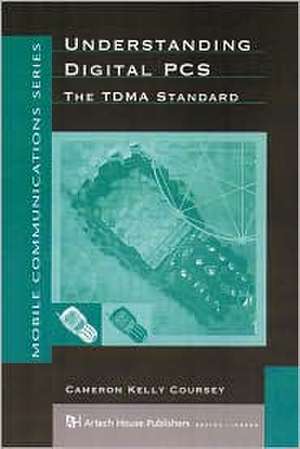Understanding Digital PCs: The Tdma Standard: Artech House Mobile Communications
Autor Cameron Kelly Courseyen Limba Engleză Hardback – 30 noi 1998
Din seria Artech House Mobile Communications
- 14%
 Preț: 950.86 lei
Preț: 950.86 lei - 14%
 Preț: 967.50 lei
Preț: 967.50 lei - 14%
 Preț: 767.41 lei
Preț: 767.41 lei - 14%
 Preț: 872.93 lei
Preț: 872.93 lei - 14%
 Preț: 783.77 lei
Preț: 783.77 lei - 14%
 Preț: 767.97 lei
Preț: 767.97 lei - 14%
 Preț: 874.28 lei
Preț: 874.28 lei - 14%
 Preț: 848.75 lei
Preț: 848.75 lei - 14%
 Preț: 856.42 lei
Preț: 856.42 lei - 14%
 Preț: 1021.19 lei
Preț: 1021.19 lei - 14%
 Preț: 946.70 lei
Preț: 946.70 lei - 11%
 Preț: 532.96 lei
Preț: 532.96 lei - 11%
 Preț: 584.87 lei
Preț: 584.87 lei - 14%
 Preț: 981.88 lei
Preț: 981.88 lei - 14%
 Preț: 836.52 lei
Preț: 836.52 lei - 11%
 Preț: 702.08 lei
Preț: 702.08 lei - 14%
 Preț: 839.81 lei
Preț: 839.81 lei - 14%
 Preț: 890.27 lei
Preț: 890.27 lei - 11%
 Preț: 669.99 lei
Preț: 669.99 lei - 14%
 Preț: 828.64 lei
Preț: 828.64 lei - 14%
 Preț: 911.02 lei
Preț: 911.02 lei - 11%
 Preț: 687.14 lei
Preț: 687.14 lei - 11%
 Preț: 484.08 lei
Preț: 484.08 lei - 18%
 Preț: 678.83 lei
Preț: 678.83 lei - 11%
 Preț: 602.35 lei
Preț: 602.35 lei -
 Preț: 224.51 lei
Preț: 224.51 lei - 18%
 Preț: 640.90 lei
Preț: 640.90 lei - 11%
 Preț: 490.86 lei
Preț: 490.86 lei - 14%
![Quantitative Analysis of Cognitive Radio and Network Performance [With DVD]](https://i3.books-express.ro/bs/9781608070985/quantitative-analysis-of-cognitive-radio-and-network-performance-with-dvd.jpg) Preț: 837.97 lei
Preț: 837.97 lei -
 Preț: 399.17 lei
Preț: 399.17 lei -
 Preț: 450.90 lei
Preț: 450.90 lei - 18%
 Preț: 710.07 lei
Preț: 710.07 lei - 15%
 Preț: 480.67 lei
Preț: 480.67 lei -
 Preț: 436.10 lei
Preț: 436.10 lei - 18%
 Preț: 678.79 lei
Preț: 678.79 lei - 18%
 Preț: 549.51 lei
Preț: 549.51 lei - 11%
 Preț: 638.46 lei
Preț: 638.46 lei - 15%
 Preț: 491.86 lei
Preț: 491.86 lei - 14%
 Preț: 676.04 lei
Preț: 676.04 lei - 20%
 Preț: 949.81 lei
Preț: 949.81 lei -
 Preț: 152.00 lei
Preț: 152.00 lei - 18%
 Preț: 771.44 lei
Preț: 771.44 lei - 14%
 Preț: 718.20 lei
Preț: 718.20 lei -
 Preț: 441.69 lei
Preț: 441.69 lei - 18%
 Preț: 511.58 lei
Preț: 511.58 lei - 14%
 Preț: 731.86 lei
Preț: 731.86 lei - 11%
 Preț: 610.31 lei
Preț: 610.31 lei -
 Preț: 121.91 lei
Preț: 121.91 lei - 20%
 Preț: 337.03 lei
Preț: 337.03 lei
Preț: 205.40 lei
Nou
Puncte Express: 308
Preț estimativ în valută:
39.30€ • 41.15$ • 32.52£
39.30€ • 41.15$ • 32.52£
Carte indisponibilă temporar
Doresc să fiu notificat când acest titlu va fi disponibil:
Se trimite...
Preluare comenzi: 021 569.72.76
Specificații
ISBN-13: 9780890063620
ISBN-10: 0890063621
Pagini: 382
Dimensiuni: 164 x 237 x 33 mm
Greutate: 0.79 kg
Editura: Artech House Publishers
Seria Artech House Mobile Communications
ISBN-10: 0890063621
Pagini: 382
Dimensiuni: 164 x 237 x 33 mm
Greutate: 0.79 kg
Editura: Artech House Publishers
Seria Artech House Mobile Communications
Cuprins
The Digital PCS Family Tree: AMPS. IS-54 TDMA. IS-136 TDMA. PCS. Advantages of Digital PCS: Capacity Enhancement. Feature Flexibility. AMPS Compatibility. The Digital PCS Family of Standards: Telecommunications Industry Association. Interim Standards and National Standards. The Digital PCS Standards. Layer 1 -- The Digital PCS Physical Layer: Channelization and Duplexing. Modulation. Power Output. Time Slot and Frame Structure. Digital Control Channel Structure. Digital Traffic Channel Structure. Channel Coding and Interleaving. Layer 2 -- The Digital PCS Data Link Layer: DCCH Protocols. DTC Protocols. Layer 3 -- The Digital PCS Network Layer: DCCH Messaging. DTC Messaging. Network Architecture and Intersystem Operation: Overview. Mobile Switching Center. Base Station. Interworking Function. Additional Network Elements. Intersystem Signaling. Mobile Station Operation: Mobile Station Types. Mobile Station States. Mobile Station Procedures. Mobile Station Identities. Reselection and Hierarchical Cell Structures: Neighbor Cells and Neighbor Cell Information. Control Channel Locking and Reselection Criteria Procedures. Reselection Trigger Conditions. Candidate Eligibility Filtering. Candidate Reselection Rules. Reselection Examples. Implementing Hierarchical Cell Structures. Mobile Sleep Mode: Paging Sub-Channel and Paging Frame Class. Processes Impacting Sleep Mode. Extending Sleep Mode with Operational Enhancements. Voice Services: Voice Coding and Decoding. Call Processing. Teleservices: Teleservice Delivery. SMS_TeleserviceIdentifier and Higher Layer Protocol Data Identifier. Teleservice Segmentation and Reassembly. Broadcast Teleservices. Defined Teleservices (including Short Message Service and Over-the-Air Activation). Circuit-Switches Data Services: Analog Circuit-Switched Data Service. Digital Circuit-Switched Data Service (including RLP1, IS-135 Data Part, and Data Call Processing). Non-Public Services: Network Types. Private and Residential System Identities. Autonomous Systems. Special Considerations for 1900 MHz Operation: Intelligent Roaming. Hyperband Reselection and Handoff. Dual-Band, Dual-Mode Mobiles. Authentication, Privacy, and Encryption: CAVE. A-Key and SSD. Authentication Procedures. Updating Shared Secret Data. Voice Privacy. Signaling Message Encryption. Encryption on the DCCH. Network Parameter Settings: Selection and Access Parameters. Reselection and Handoff Boundaries. Equipment Testing: Network Testing. Mobile Testing (including Performance Testing, Interoperability Testing, and Protocol Conformance Testing). Towards Global TDMA: The Universal Wireless Communications Consortium. Global TDMA Forum. Global WIN Forum. Global Operators’ Forum. The Future of Digital PCS: IMT-2000 and Third Generation Cellular. 136+. 136HS. Potential Further Digital PCS Enhancements.
Descriere
Digital PCS (otherwise known as ANSI-136) is one of today's most successful TDMA cellular standards, offering cellular customers superior network capacity coupled with advanced features. This book explains how the ANSI-136 compliant mobile phone operates and how it works together with the cellular network to allow customers to send and receive calls.
